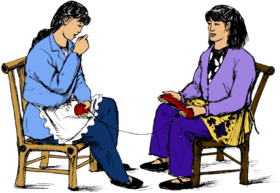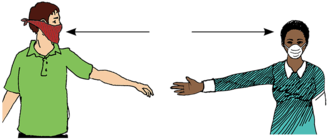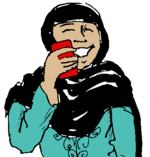Hesperian Health Guides
Coronavirus — COVID-19
Contents
What is COVID-19?
COVID-19 is a disease caused by a virus (coronavirus) that can spread between people. The most common signs of COVID-19 are a dry cough, fever, and body aches. Some people also have shortness of breath, loss of taste or smell, and sore throat. COVID-19 mostly affects the respiratory (breathing) system. Most people who become infected recover without needing medical treatment, but some become dangerously ill. COVID-19 can cause pneumonia (a serious infection of the lungs), can damage the lungs, heart, and kidneys, and in severe cases can lead to death.
Viruses constantly change, leading to different forms of the same virus called “variants.” Some variants of COVID-19 spread faster and more easily than others. Vaccination is the best way to protect yourself from getting or spreading any of the COVID-19 variants.

COVID-19 enters your body through the mouth, nose, and eyes when an infected person breathes, talks, coughs, or sneezes near you or on surfaces you touch, and you then touch your eyes, nose or mouth. COVID-19 spreads more easily in places with poor ventilation and where people are close together. So being indoors or in crowds puts you at higher risk than being outdoors and avoiding large groups of people.
Most people start feeling sick about 5 days after getting infected, but COVID-19 can live in the body for 2 to 14 days before signs of illness appear. Some people, especially children, can be infected but have no signs of illness. So people can have COVID-19 and not know it, and can pass the virus to others.
Anyone can get infected with COVID-19, although people who are vaccinated and people who already had it are less likely to get it. Adults over 60 years old and people with respiratory illnesses, diabetes, heart problems, and weakened immune systems are at greater risk of severe illness from COVID-19.
How can you prevent infection?

Getting vaccinated is the best way to prevent COVID-19 infection in yourself and others. As more people are vaccinated, the virus will be less able to spread. Until vaccines are available to everyone, you can take steps to protect yourself and others.
- Wear a mask: Because some people can be infected without knowing it, if everyone wears a simple cloth or paper mask, this can stop COVID-19 from spreading. Wear a mask that is clean and dry, that covers your mouth and nose completely. Do not use a mask with valves. Wash cloth masks regularly. If caring for a person who might have COVID-19, N95 respirator masks give the best protection. If using a cloth mask, use one with 2 or 3 layers.
- Clean your hands with soap and water or an alcohol-based hand rub, then cover your mouth and nose with the mask, making sure there are no gaps between your face and the mask.
- Do not touch the mask while wearing it, and put on a new one if it becomes damp.
- To remove the mask, use the straps to take it off (don’t touch the mask itself). If you are discarding it, put it in a closed bin and clean your hands after.
- It is best not to reuse medical masks. If you must reuse an N95 respirator mask, bake it at 75°C (167°F) for 30 minutes to disinfect it. Or, if you have at least 5, put each in a separate container (like a paper bag) which allows them to dry, and rotate their use so you only use each mask once every 5 days.
- Avoid close contact: Keep 2 meters (6 feet) away from people who don’t live in your household.
- Avoid crowds and places with poor ventilation: Move interactions with others outdoors to lessen the amount of virus you come in contact with. If you must be indoors, open windows and doors to bring in fresh air, and minimize the number of people you are with and for how long. Outdoors and indoors, wear a mask!
- Wash your hands frequently with soap and water or an alcohol-based hand-rub.
- Wash vigorously with soap and water for at least 20 seconds, making sure to clean your entire hand, wrist, and lower arm.
- Always wash hands when returning home, after using the bathroom, before meals, and after you cough, sneeze, or blow your nose. Avoid touching your face without first washing your hands.
- If soap and water are not available, use an alcohol-based hand-rub with at least 60% alcohol. Rub your hands together for 20 seconds, or until they feel dry.
- If you live with someone who has COVID-19: The sick person should stay home and apart from others in the household, avoiding shared spaces as much as possible. When they are in close contact with other household members, everyone should wear a mask. Clean surfaces that are touched frequently (such as countertops and doorknobs) using soap and water, followed by alcohol or bleach. Make new cleaning solutions each day so they are effective. Do not mix cleaning products together, because this can produce dangerous fumes to breathe.
- Alcohol: Solutions with 70-90% ethanol or isopropyl alcohol are best at killing the COVID-19 virus quickly. If your alcohol is 100%, then add water in a ratio of 1 cup water to 2 cups alcohol.
- Bleach: Bleach usually comes in a 5% solution. For floors and large surfaces, use 2 cups bleach in a 5-gallon bucket of cool water (500 ml bleach in 20 liters water) and let it air dry.
- Monitor your health: If you have a cough, fever, difficulty breathing, body aches, or sore throat, first check with your health clinic or local health official, online or by phone, for instructions on how and where to get treatment. Because the most serious danger from COVID-19 is inability to breathe, treatment for severe cases will include oxygen and a mechanical ventilator, available only in health care facilities.
To use a mask properly:



